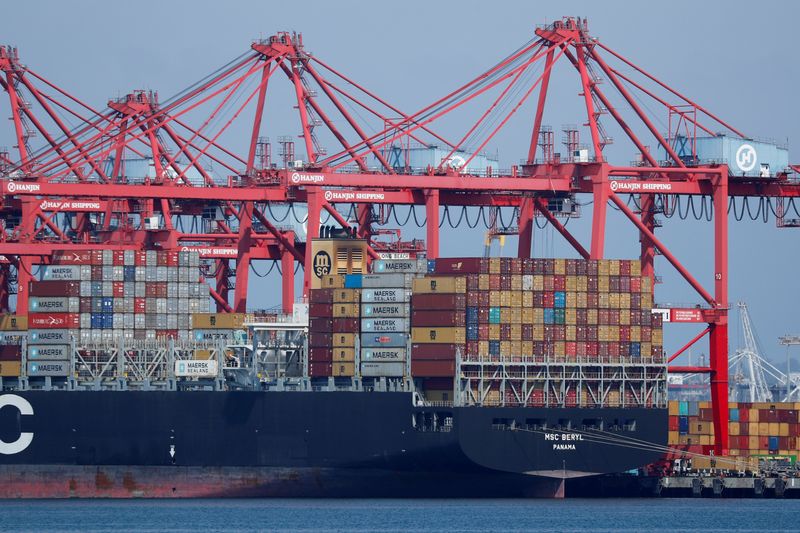By Lucia Mutikani
WASHINGTON (Reuters) - New orders for key U.S.-manufactured capital goods rebounded more than expected in April and shipments of those goods also increased, suggesting a moderate improvement in business spending on equipment early in the second quarter.
Nonetheless, business investment on equipment continues to be hamstrung by higher borrowing costs. That, together with a strong dollar and weak global demand, is keeping manufacturing, which accounts for 10.4% of the economy, on the ropes.
"Despite elevated borrowing costs and stricter loan standards, U.S. business investment could pick up in the second quarter," said Sal Guatieri, a senior economist at BMO Capital Markets. "However, the manufacturing sector, as a whole, is expected to remain in low gear until interest rates ease, the greenback weakens, and the global economy strengthens."
Non-defense capital goods orders excluding aircraft, a closely watched proxy for business spending plans, rose 0.3% last month after an upwardly revised 0.1% dip in March, the Commerce Department's Census Bureau said on Friday.
Economists polled by Reuters had forecast these so-called capital goods orders would edge up 0.1% after declining by a previously reported 0.2% in March.
The government last week revised the orders, shipments and inventory data from January 2012 through March 2024 after an annual review of the seasonal adjustment models, which it uses to strip seasonal fluctuations from the numbers. The revision did not affect the unadjusted data.
Core capital goods orders jumped 1.2% on a year-on-year basis in April. Shipments increased 0.4% after a 0.3% drop in March. Non-defense capital goods orders fell 1.5% in April after advancing 1.3% in the prior month. Shipments of these goods rose 2.4% after dropping 1.5% in March.
These shipments go into the calculation of the business spending on equipment component in the gross domestic product report. They were partially flattered by higher prices, which could lessen the boost to GDP.
Economists at Goldman Sachs raised their second-quarter GDP growth estimate to a 3.2% annualized rate from a 3.1% pace. Business spending on equipment rebounded marginally in the first quarter after two straight quarterly declines, making a small contribution to the economy's 1.6% growth pace.
Stocks on Wall Street were trading higher. The dollar fell against a basket of currencies. The prices of longer-dated U.S. Treasuries rose.
CONSUMER SENTIMENT SAGS
Investment has been hampered by Federal Reserve policy tightening that has lifted the U.S. central bank's benchmark interest rate by 525 basis points since March 2022, eroding demand for goods and raising financing costs for businesses.
The Fed is expected to start lowering borrowing costs in September. It has kept its policy rate in the 5.25%-5.50% range since July. The prospect of policy easing by the end of the third quarter received a boost from a University of Michigan survey on Friday showing consumers' inflation expectations improved in late May after deteriorating early in the month.
The survey's 12-month inflation expectation fell to 3.3% from 3.5%. The five-year inflation outlook improved to 3.0% from 3.1% earlier this month.
Consumer sentiment, however, fell to a five-month low on mounting fears about borrowing costs staying high. At face value, pessimism among households would imply slower consumer spending. But the relationship between the two has been weak.
The Commerce Department report showed orders for durable goods, items ranging from toasters to aircraft meant to last three years or more, rose 0.7% in April after a downwardly revised 0.8% gain in March. Durable goods orders were previously reported to have increased 0.9% in March.
Orders were lifted by a 1.2% rise in transportation equipment, which followed a 2.5% acceleration in March.
Orders for motor vehicles and parts increased 1.5% after jumping 2.8% in March. Commercial aircraft orders decreased 8.0% after rising 7.7% in March. Boeing (NYSE:BA) reported on its website that it had received only seven aircraft orders in April, sharply down from 113 in the prior month.
Orders for computers and electronic products rose 0.6% last month, while those for electrical equipment, appliances and components shot up 0.9%. There were also increases in orders for machinery and fabricated and primary metals.

Shipments of durable goods increased 1.2% after edging up 0.1% in March. Durable goods inventories nudged up 0.1%. Unfilled orders climbed 0.2%.
"While growth remains positive for now, uncertainty about the rate path may weigh on orders going forward," said Rubeela Farooqi, chief U.S. economist at High Frequency Economics. "However, a push from fiscal spending could be positive for orders and investment over time."